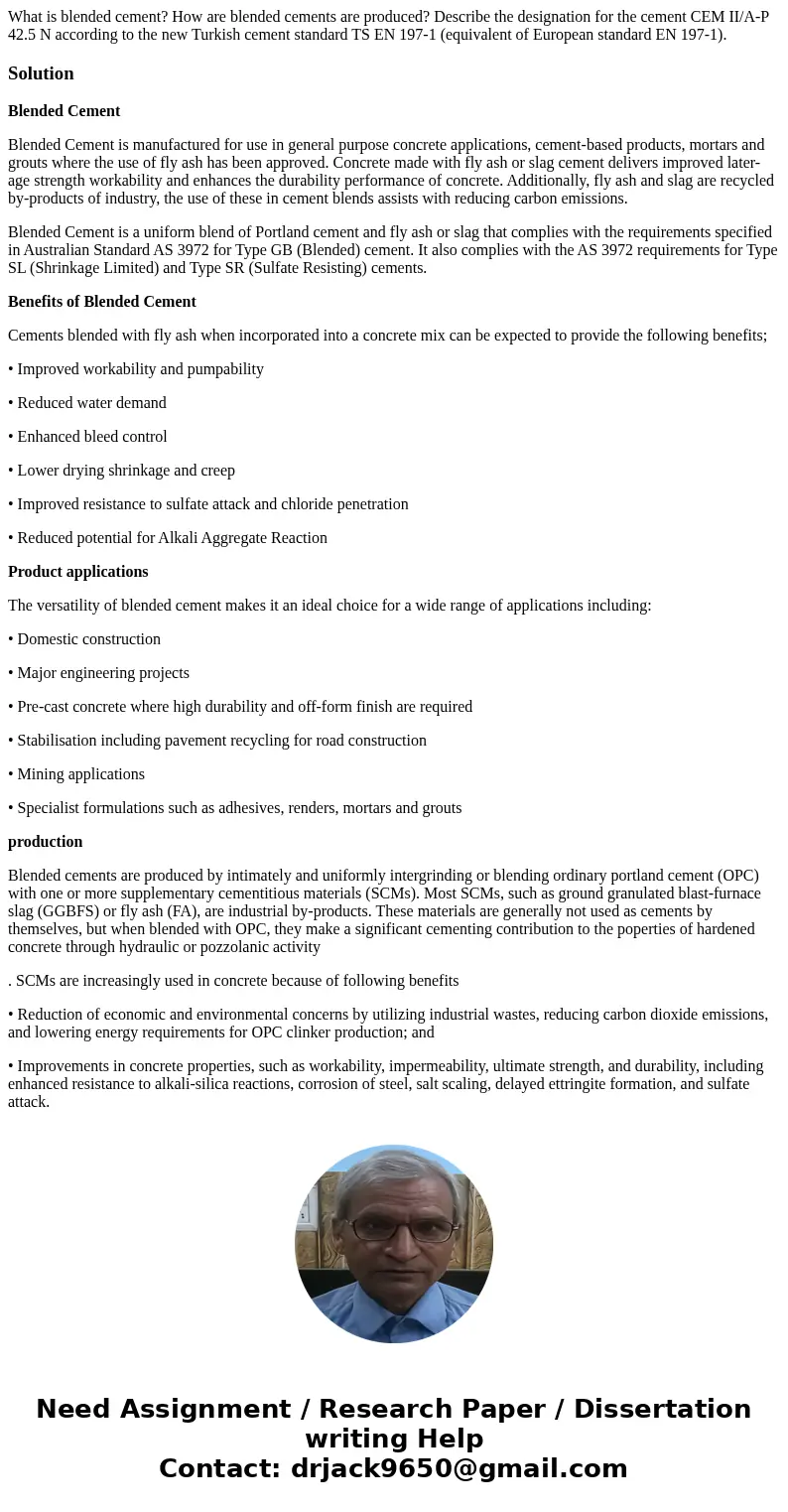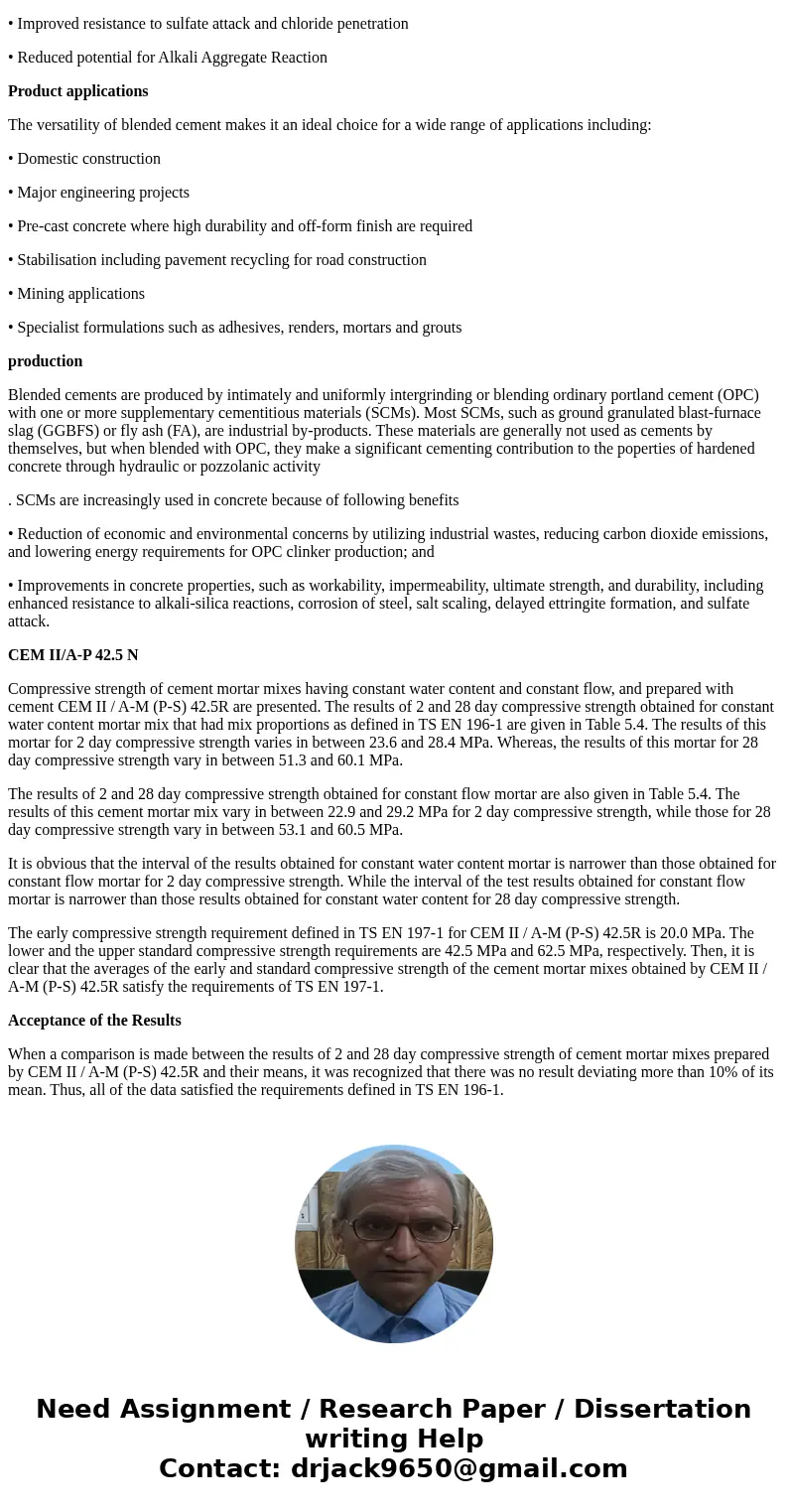What is blended cement How are blended cements are produced
What is blended cement? How are blended cements are produced? Describe the designation for the cement CEM II/A-P 42.5 N according to the new Turkish cement standard TS EN 197-1 (equivalent of European standard EN 197-1).
Solution
Blended Cement
Blended Cement is manufactured for use in general purpose concrete applications, cement-based products, mortars and grouts where the use of fly ash has been approved. Concrete made with fly ash or slag cement delivers improved later-age strength workability and enhances the durability performance of concrete. Additionally, fly ash and slag are recycled by-products of industry, the use of these in cement blends assists with reducing carbon emissions.
Blended Cement is a uniform blend of Portland cement and fly ash or slag that complies with the requirements specified in Australian Standard AS 3972 for Type GB (Blended) cement. It also complies with the AS 3972 requirements for Type SL (Shrinkage Limited) and Type SR (Sulfate Resisting) cements.
Benefits of Blended Cement
Cements blended with fly ash when incorporated into a concrete mix can be expected to provide the following benefits;
• Improved workability and pumpability
• Reduced water demand
• Enhanced bleed control
• Lower drying shrinkage and creep
• Improved resistance to sulfate attack and chloride penetration
• Reduced potential for Alkali Aggregate Reaction
Product applications
The versatility of blended cement makes it an ideal choice for a wide range of applications including:
• Domestic construction
• Major engineering projects
• Pre-cast concrete where high durability and off-form finish are required
• Stabilisation including pavement recycling for road construction
• Mining applications
• Specialist formulations such as adhesives, renders, mortars and grouts
production
Blended cements are produced by intimately and uniformly intergrinding or blending ordinary portland cement (OPC) with one or more supplementary cementitious materials (SCMs). Most SCMs, such as ground granulated blast-furnace slag (GGBFS) or fly ash (FA), are industrial by-products. These materials are generally not used as cements by themselves, but when blended with OPC, they make a significant cementing contribution to the poperties of hardened concrete through hydraulic or pozzolanic activity
. SCMs are increasingly used in concrete because of following benefits
• Reduction of economic and environmental concerns by utilizing industrial wastes, reducing carbon dioxide emissions, and lowering energy requirements for OPC clinker production; and
• Improvements in concrete properties, such as workability, impermeability, ultimate strength, and durability, including enhanced resistance to alkali-silica reactions, corrosion of steel, salt scaling, delayed ettringite formation, and sulfate attack.
CEM II/A-P 42.5 N
Compressive strength of cement mortar mixes having constant water content and constant flow, and prepared with cement CEM II / A-M (P-S) 42.5R are presented. The results of 2 and 28 day compressive strength obtained for constant water content mortar mix that had mix proportions as defined in TS EN 196-1 are given in Table 5.4. The results of this mortar for 2 day compressive strength varies in between 23.6 and 28.4 MPa. Whereas, the results of this mortar for 28 day compressive strength vary in between 51.3 and 60.1 MPa.
The results of 2 and 28 day compressive strength obtained for constant flow mortar are also given in Table 5.4. The results of this cement mortar mix vary in between 22.9 and 29.2 MPa for 2 day compressive strength, while those for 28 day compressive strength vary in between 53.1 and 60.5 MPa.
It is obvious that the interval of the results obtained for constant water content mortar is narrower than those obtained for constant flow mortar for 2 day compressive strength. While the interval of the test results obtained for constant flow mortar is narrower than those results obtained for constant water content for 28 day compressive strength.
The early compressive strength requirement defined in TS EN 197-1 for CEM II / A-M (P-S) 42.5R is 20.0 MPa. The lower and the upper standard compressive strength requirements are 42.5 MPa and 62.5 MPa, respectively. Then, it is clear that the averages of the early and standard compressive strength of the cement mortar mixes obtained by CEM II / A-M (P-S) 42.5R satisfy the requirements of TS EN 197-1.
Acceptance of the Results
When a comparison is made between the results of 2 and 28 day compressive strength of cement mortar mixes prepared by CEM II / A-M (P-S) 42.5R and their means, it was recognized that there was no result deviating more than 10% of its mean. Thus, all of the data satisfied the requirements defined in TS EN 196-1.


 Homework Sourse
Homework Sourse